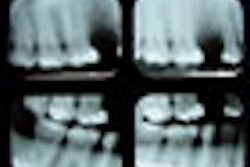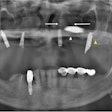There may be some association between dental x-rays and certain types of cancer, according to a review by the Canadian Agency for Drugs and Technologies in Health (CADTH; Journal of the Canadian Dental Association, 2012; 78:c79).
Based on data from eight case-control studies that assessed the association between exposure frequency to dental x-rays and brain tumors (five reports), thyroid cancer (one report), breast cancer (one report), or pediatric cancer of connective tissues (one report), the CADTH review presents some evidence that dental x-rays may increase the risk for cancer, the agency noted.
"There is some evidence of an association between exposure to dental x-rays and meningioma, and thyroid cancer or breast cancer, when shielding with a lead apron is not used," the CADTH wrote. "An association between pediatric rhabdomyosarcoma and maternal exposure to x-rays was also detected. No association between gliomas or acoustic neuromas and dental x-rays were detected."
However, these findings should be interpreted with caution, as only one study was available for some cancers, the CADTH noted.
Other study limitations include the following:
- All data on x-ray exposure frequency from decades earlier was self-reported; only one study verified exposure history, using dental records, but only for a subset of patients.
- The association between x-rays and cancer could be substantially overestimated if patients who had developed cancer were more likely than controls to recall their history of x-ray exposure frequency.
- The ability of cancer patients, particularly those with brain tumors, to accurately recall their history of x-ray exposure frequency may have been affected by the disease or disease treatment.
- For studies that examined the frequency of different types of dental x-rays, patients may have had difficulty in distinguishing between each type of x-ray (e.g., bitewing versus full mouth x-rays).
Click here to read the Canadian Dental Association's position statement on controlling radiation exposure in dentistry.



















